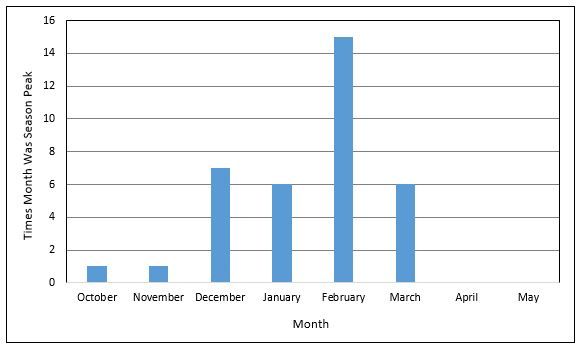Why Warmer Weather Probably Won’t Stop COVID-19
Yes, most infectious diseases are seasonal. But waiting for COVID-19 to wane on its own is a bad idea
/https://tf-cmsv2-smithsonianmag-media.s3.amazonaws.com/filer/7c/ae/7cae19b7-9783-47b4-931c-1b9becc589f3/gettyimages-1133904319.jpg)
COVID-19 is not the flu. But amidst the ongoing pandemic, many people hold out hope that the two diseases have something crucial in common: a seasonality that will loosen the global grip of SARS-CoV-2 as the weather warms.
Many infectious diseases wax and wane with the changing months. Some, like flu, spike when the weather turns cold, while others, like cholera, thrive during warm, rainy summers. Whether such a pattern applies to SARS-CoV-2 is unclear. With spring just barely sprung, scientists haven’t had the time to suss out SARS-CoV-2’s annual schedule—if it sticks to one at all.
Besides, relying on seasonality to curb a pandemic can be a dangerous line of thought, says C. Brandon Ogbunu, a computational epidemiologist at Brown University.
“Seasonality has the potential to decrease the rate of infection,” he says. But this factor alone won’t get the world anywhere close to resolving the outbreak. “If I was a betting person … all [my money] would be on the impact of human behavior and infrastructure” to slow transmission, he adds. “That’s where we need to put our emphasis.”
Why Are Diseases Seasonal, Anyway?
The first time a severe infectious disease tears through a new population, it’s sure to wreak havoc. Without previous exposure, no members of the community are immune, leaving the virus with numerous potential hosts to sustain it for months to come, regardless of the weather forecast.
Columbia University epidemiologist Micaela Martinez compares early outbreaks to a fire igniting in a forest full of kindling. The occasional rainstorm might do a bit to slow the conflagration. But with so many vulnerable trees, a touch of precipitation would be nowhere near enough to snuff out the flames. “For the first wave, the seasonality is not as relevant,” she says. “We can’t expect [the virus] to just go away.”

Once the current pandemic subsides, however, future infections would propagate amongst a population with a smaller proportion of immune individuals. These likely tamer outbreaks could reveal a seasonal cycle, which Martinez believes is a quality ubiquitous among infectious diseases. In 2018, she set out to catalog these trends and was surprised to find that all of the nearly 70 infections she studied showed some sort of seasonal rise and fall.
Generally speaking, Martinez says, each season comes with a distinct infectious twist: Winter winds bring bouts of pneumonia, flu and other respiratory diseases before the blooms of spring usher in bursts of chickenpox and herpes. The arrival of summer sees spikes in Lyme disease, polio and syphilis before autumn resets the cycle with blips of yellow fever. Other diseases are generalists, favoring any extended period of dryness or rain, especially in and around the tropics where seasonal boundaries blur.
Disentangling the drivers of these patterns is a complex pursuit. Some factors are obvious: Infections caused by bacteria, parasites or viruses that must be ferried from host to host by an insect vector like a mosquito will inevitably ebb and flow with the natural breeding seasons of their buggy chauffeurs. In other cases, the environment can have a direct effect on the pathogen, Ogbunu says. Some viruses—including influenza and SARS-CoV-2—are packaged in a fragile, fatty outer layer called an envelope that’s both necessary for infection and sensitive to harsh conditions, including heat and the ultraviolet rays found in sunlight. High humidity can weigh down the infectious, airborne droplets needed to ferry the virus from person to person, preventing the microbes from traveling as far.
To further complicate matters, our bodies feel the effects of weather and climate. Studies in mice have shown that low humidity can compromise the germ-trapping mucus in their airways and impair the production of critical immune molecules, leaving the rodents more vulnerable to flu viruses, explains Laura Yockey, a virologist at Massachusetts General Hospital.
And biology doesn’t manifest in a vacuum. Disease-transmitting behavior also shifts with the seasons, triggering outbreaks that can even override a pathogen’s typical itinerary. Children returning to school at the beginning of fall, for example, can prompt an uptick in certain infections like chickenpox. Similarly, people gathering indoors during rainy summer months can spread flu during its “off” season.
These patterns are so pronounced that they “almost form a calendar” of pathogens that humans can track and follow, says Elena Naumova, an epidemiologist at Tufts University. “I honestly believe by nature, life on our planet is seasonal,” she says. “Therefore, infections are seasonal, too.”
What We Can Do Right Now
As a respiratory virus with a delicate envelope, SARS-CoV-2 has several traits that might someday reveal a seasonal pattern. Years from now, if or when the pathogen returns to the human population, COVID-19 cases may peak when the weather is consistently cold and dry, before dipping down in summer months. For now, though, Naumova says that passively waiting for the virus to disappear is “nonsense.” A population’s suceptibility to a given infection trumps all else. And with so many vulnerable individuals around, any warmth-related wanes in disease will do little to rein in its spread.
Seasonality’s influence—or lack thereof—on this coronavirus shouldn’t inspire feelings of helplessness. Quite the opposite, Naumova says. “We cannot control the weather,” she says, but we can control “how we prepare for that specific weather.” The same goes for infectious disease. As such, humans should take charge of the disease driver they know best: their behaviors. As the pandemic continues to evolve, Ogbunu stresses the importance of continuing to drive down risks for transmission. Practicing good hygiene, avoiding crowds and being mindful of our surroundings remain crucial—to protect not only ourselves, but also those around us whose wellbeing depends on the actions of their fellow community members.
“One of the main drivers of epidemics are contact rates,” Martinez says. “It can make a huge impact on disease transmission. Just like it can drive epidemics, it can stop them.”
/https://tf-cmsv2-smithsonianmag-media.s3.amazonaws.com/accounts/headshot/10172852_10152012979290896_320129237_n.jpg)


/https://tf-cmsv2-smithsonianmag-media.s3.amazonaws.com/accounts/headshot/10172852_10152012979290896_320129237_n.jpg)